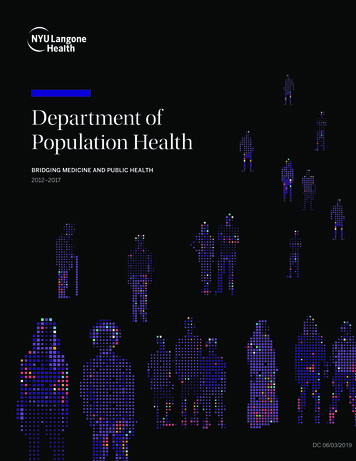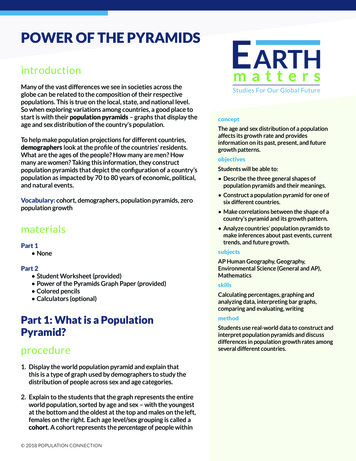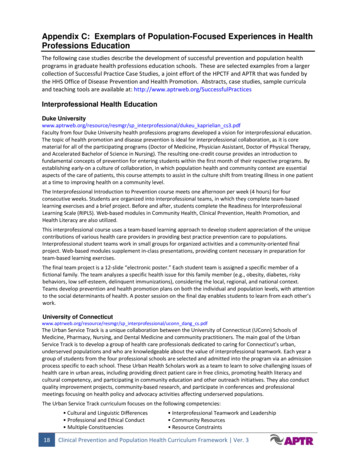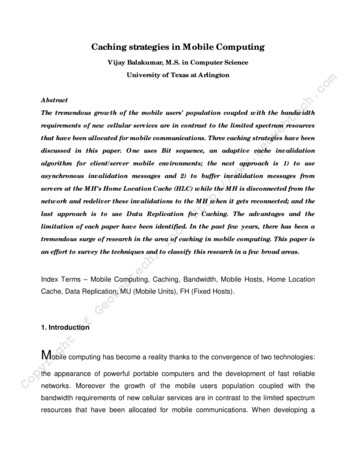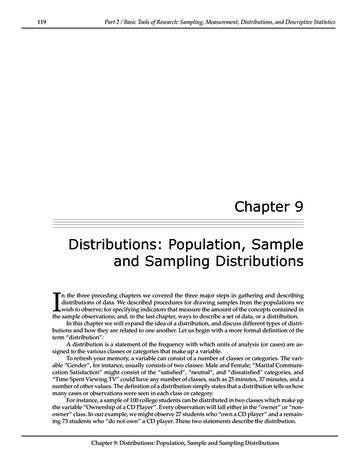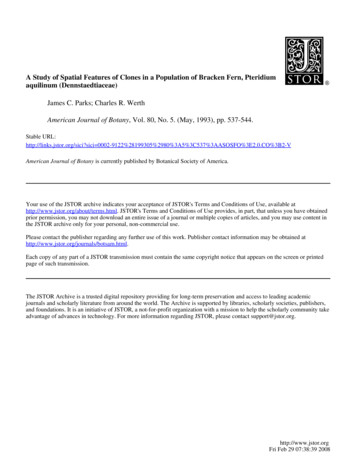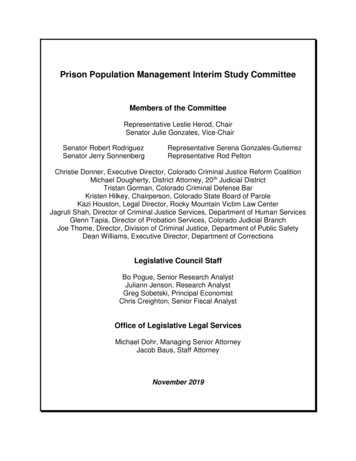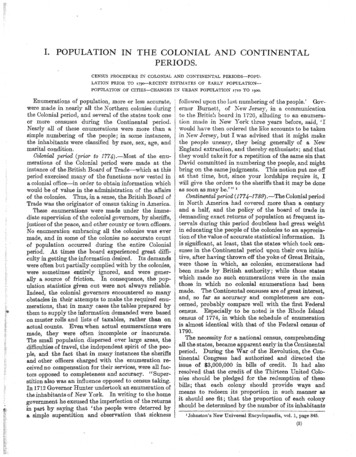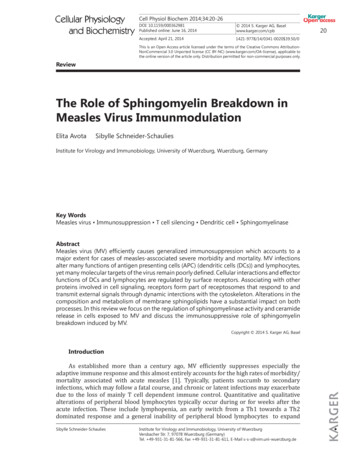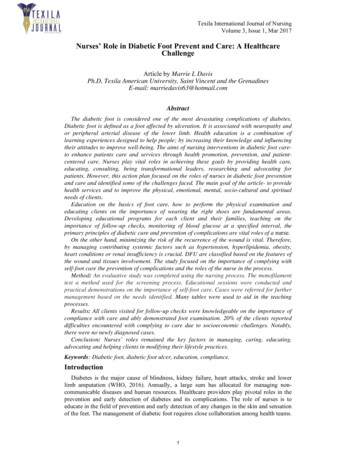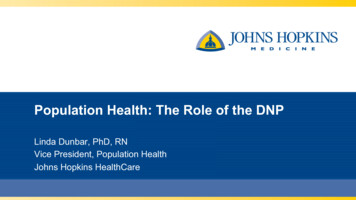
Transcription
Population Health: The Role of the DNPLinda Dunbar, PhD, RNVice President, Population HealthJohns Hopkins HealthCare
TOPICS in Population Health DefinitionsHopkins’ Conceptual ModelInterventionsRelationship to Data and Research– Intervention Research Roles for Nursing, DNP Discussion2
Population Health Definitions Population Health:– A cohesive, integrated and comprehensive approach tohealth care considering the distribution of health outcomeswithin a population, the health determinants that influencedistribution of care, and the policies and interventions thatare impacted by the determinants. Population Health Management:– The process of addressing population health needs andcontrolling problems at the population level; strategies toaddress population health needs3
4
Using all available data to understandmorbidity, health priorities, health risk,and targets for intervention5
How we understand morbidity and risk ina population: Factors that contribute tohealth outcomes6
Based on identified population needs, design andimplement appropriate interventions for each level of risk7
Engage all stakeholders, monitor programimplementation, and seek to continuouslyimprove programs to maximize health outcomes8
Defining Population HealthInterventions Programs, policies, and resource distributionapproaches that impact a number of people bychanging the underlying conditions of risk and byfacilitating health improvement or maintenance for thepopulation as a whole.– Implemented within and outside of the health sector– Allows a comprehensive and multi-faceted approach toplanning and delivering programs and interventions
Characteristics of Population HealthInterventions Well-planned, well-placed, and well-conducted Specificity Lead to increased efficiency and effectiveness through appropriateresource allocation to meet varying needs of the population andpopulation sub-groups Adherence to r-healthy-aging/content-library/IssueBrief ReAim onImplementationMaintenance and cost (sustainability)
Merger ofPublic Health andClinical InterventionFrameworksPublic Health InterventionWheel11
Clinical Intervention FrameworkSpecificity and appropriateness Interventions to manage care for people with complicatedand chronic health problems such as diabetes, heartdisease, cancer, chronic pain. Aims to improve diseasecontrol, prevent further physical deterioration, andmaximize quality of life. Interventions to halt or slow the progression of disease atits earliest stages. Interventions to protect people at risk from developing adisease or health condition (screenings).Tertiary PreventionPrimary Prevention12
Key Elements of Population HealthInterventions within the Health Sector! Collaborative, Team-Based Care! Integrated primary care! Coordinated care (including transition from inpatient to outpatient care)! Inclusion of:! Case management (individual patient assessment and care plan)! Patient self-management support personnel and programs (health educators, coaches, use of assessment,care plan and intervention)! Flexible model of Specialist Integrated primary care! Multiple delivery modalities and options! In-clinic! Telephone-based! Web-based! Clinic-community partnerships! Community-based surveillance, health promotion and support using lay health agents! Design and implementation of risk behavior protocols and programs (nutrition, fitness, weightmanagement) that are flexible, adapted to address patients at different risk stratification levels! Eradicate the normal curve effectiveness approach
Examples of Population Health InterventionsOutside of the Health Sector! Introduction of organizational changes in workplace design! Employee wellness initiatives targeting health behaviors and conditionsof highest risk and prevalence in the population! Flexible to target primary and secondary prevention needs! Implementation of health-related intervention programs within primaryand secondary schools! Design of neighborhoods and communities to facilitate physical activity! Use of policy to tie benefits and incentives to health-promotingbehaviors and penalties to risk behaviors! Use of behavioral principles to influence design of restaurants, cafeteriasto promote healthier eating
Building the Workforce for CollaborativeCareConduct inventory of personnel deliveringbehavioral, psychosocial, and educationalinterventionsCase ManagersNurse EducatorsHealth CoachesCommunity Health WorkersSocial WorkersNutritionists/DieticiansPsychologists, PsychiatristsPharmacistsStandardization of Intervention ProtocolsConduct inventory of intervention protocolsand materials in use by personnel deliveringbehavioral, psychosocial, and educationalinterventionsEvaluate sources of current protocols andmaterials, variability in approaches beingused, usefulness, limitations, and content gapsDelineate"Scope of work/practice based onregulatory guidelines for the healthprofessions."Roles of licensed/certified practitionerpersonnel vs. unlicensed personnelcategoriesPromote and facilitate use of interventionapproaches and protocols that are consistentwith available practice standards andevidence-based care.Provide training for personnel in standardizedprotocols available for their scope of workwithin the collaborative care delivery systemModify or develop protocols based on:Evidence of effectiveness, best practicesNCQA requirements (case management)Behavioral and Psychosocial PracticeGuidelinesAvailable Patient Education PracticeGuidelines for medical conditionsRequirements for process and outcomereporting, indicatorsFor services to be billed, content definitionsfrom CMS procedure codes for patienteducation, nutrition, and health behaviorassessments and interventionsPrepare protocols for intended deliverymodality(ies):Clinic-basedRemote (web-based, telephone)Home- or community-basedImplementationMedical provider and practice site orientation to collaborative careIT Infrastructure to support: EMR capacity for task assignments, referrals to behavioralpersonnel, and shared documentation of behavioral and case management services andprogressWorkforce deployment within the healthcare delivery system15
Relationship of Data and Analytics toPopulation Health Interventions1. Surveillance and assessment to determine populationneeds and patterns, and (over time) to track populationlevel health changes or trends resulting from interventions2. Identification of population sub-groups in need ofparticular interventions (e.g. risk stratification)Population HealthInterventionResearch3. Monitoring of intervention processes, procedures, andimplementation4. Evaluation of intervention effect on designated clinical,behavioral, community, health system, and economicoutcomes16
Population Health Intervention Research Research that involves the use of scientific methods toproduce knowledge about policy and program interventionsthat operate within or outside of the health sector and havethe potential to impact health at the population level.– Population Health Research Initiative for Canada (http://www.cihr-irsc.gc.ca/e/38731.html)
Roles for Nursing Big Data– Data skills coupled with ability to understand clinical morbidity & health risksProgram Development– Design of appropriate interventions within each level of risk– Incorporating a whole person perspective with factors that contribute to healthoutcomes (environmental, social/behavioral, genetic and biologic)Population Health Policy– Influencing International, Federal, State, payor policies regarding payment andservice delivery supporting population healthAdministrative/Leadership– Leadership and Vision– Management– Training18
19
DiscussionLinda Dunbar PhD RNVice President Population HealthJohns Hopkins HealthCare6704 Curtis CourtGlen Burnie, Maryland 21060410-424-4689ldunbar@jhhc.com20
Roles for Nursing Big Data – Data skills coupled with ability to understand clinical morbidity & health risks Program Development – Design of appropriate interventions within each level of risk – Incorporating a whole
